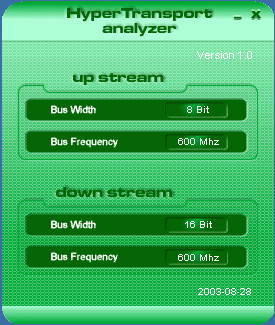
|
The K8NNXP boasts an impressive list of features, workstation-oriented
addons, and performance stats that should make it a crowd favorite among
demanding users.
90% Rating: 
|
|
|
|
Home >
Reviews >
Motherboards >
Gigabyte GA-K8NNXP |
|
|
nForce3 150 Chipset
 |
| VIA's HyperTransport Analyzer, available here,
allows you to test any Athlon64 motherboard and
subsequent K8 chipset to see it meets the Hypertransport spec. We ran the
test on the nForce3-based Gigabyte K8NNXP and found the NF3's upstream
data pipe to be only 8 bits wide. The Hypertransport Bus
Frequency was running at 600 MHz, as is expected with the nForce3
150 chipset. The spec bus frequency is 800MHz, for comparisons
sake. |
The Nforce3 150 is Nvidia's current chipset for the
socket 754 AMD Athlon64 processor, and like previous nForce solutions, is a single chip
design.
The functions of the traditional
'Northbridge' and 'Southbridge' are integrated into a single package, which then
communicates with the Athlon64 processor via a Hypertransport link. All I/O
subsystems connect directly to the nForce3, enabling the data to be marshaled
internally onto the Hypertransport link for access to the processor and memory
controller directly.
Nvidia isn't as forthcoming about the
exact specs of the Hypertransport link inside the nForce3 as some other
manufacturers, but they do reveal that it provides a maximum bandwidth
of 3.6GBps. That amount is more than adequate to deal with the demands of
current graphics and I/O technology, as detailed above.
You might be wondering if there are any downsides to
packing everything into one core logic chipset, but the benefit of this arrangement is mainly the
reduced latency that should be achieved by placing all the IO functions
on essentially a single path between the chipset and the CPU.
As far as features
go, along with the usual array of USB 2.0, basic audio, PCI, 10/100
Ethernet and parallel ATA, the Nforce3 Pro 150 integrates RAID into the equation. Motherboard
manufacturers can add serial ATA support, gigabit Ethernet, or even IEEE 1394B
with external controllers, as has been done with the Gigabyte K8NNXP.
VIA have created a handy
little tool called the "Hypertransport Analyzer" to espouse the apparent
benefits of using their K8T800 chipset which operates at the maximum levels of
the Hypertransport spec.
In theory, nVidia's nForce3
150 is not as "fast" (and by that I mean from a users perspective) as VIA's
K8T800 chipset because nVidia's nForce 3 HyperTransport link runs at a little
slower pace to keep its signal integrity valid. Upstream and downstream rates of
HyperTransport on the NF3 run at 600 MHz, as opposed to 800 MHz on the VIA
K8T800 platform. We also found that the upstream data pathway for the NF3 was
only 8 bits wide instead of 16 bits. The NF3's downstream pathway was 16 bits
wide.
The good news for nVIDIA
is that this slight shortcoming shouldn't affect 2D applications much, if at all
because typical office applications tend to focus on few peripherals other than
the hard drive. As you'll see in the benchmarks a little later, the NF3 only
takes a slight hit when it comes to 3D performance due to the slower
HyperTransport links. Rumors are that Nvidia also plan to release a revised
version of the nForce3 150, entitled the nForce 3 Pro 250 which will use full
speed 16 bit HyperTransport links up, and downstream.
Of course, unified drivers are what make nVidia's
products so simple to use, and the newly released NV System Utility is just one example of how nVidia
are providing the tools enthusiasts need to tweak their systems even
faster...
|
